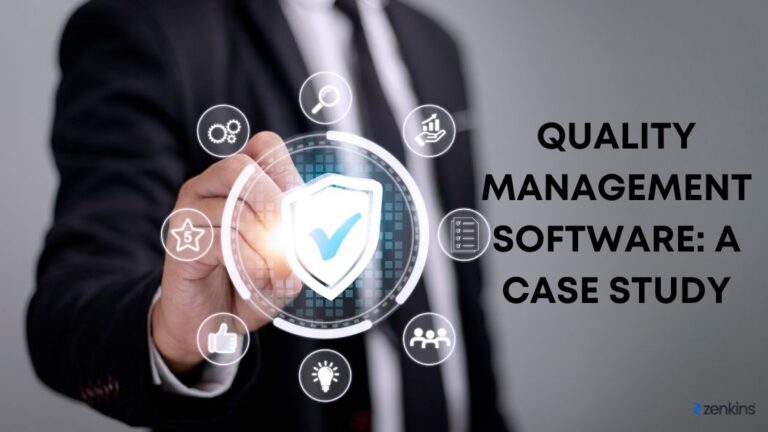Product Lifecycle Management System Case Study
Table of Contents
Overview
In today’s fast-paced and competitive market, managing the lifecycle of a product from inception through design, manufacturing, service, and disposal is critical. A robust Product Lifecycle Management (PLM) system is essential for organizations to streamline processes, enhance productivity, and ensure product quality. This case study delves into how Zenkins successfully developed a customized PLM system for a leading manufacturing company, transforming their product management approach and driving significant business growth.
Client Background
Our client, a global leader in the manufacturing sector, faced challenges in managing their complex product development processes. With numerous products, extensive supply chains, and a need for rigorous quality control, they required a comprehensive PLM solution to integrate various functions and streamline workflows. The existing disparate systems led to inefficiencies, miscommunication, and delays, impacting their ability to innovate and respond to market demands swiftly.
The Challenge
The primary challenge was to develop a PLM system that could seamlessly integrate with the client’s existing infrastructure while addressing the following critical needs:
- Centralized Data Management: Ensuring all product-related information was accessible from a single source of truth.
- Fragmented Processes: The client’s product development process was fragmented, with different teams using disparate systems and tools, leading to inefficiencies and miscommunications.
- Improved Collaboration: Facilitating better communication and collaboration across different departments and stakeholders.
- Enhanced Process Efficiency: Automating and optimizing product development processes to reduce time-to-market.
- Regulatory Compliance: Ensuring compliance with industry standards and regulations throughout the product lifecycle.
- Scalability: Creating a system that could grow with the company and adapt to future needs.
- Time-to-Market Delays: The fragmented processes and inefficiencies contributed to delays in bringing products to market.
Zenkins’ Solution
To address these challenges, Zenkins proposed a comprehensive PLM solution designed to streamline processes, enhance collaboration, and ensure compliance. The solution involved the following key components:
- Unified PLM Platform: Implementing a centralized PLM platform to integrate all product data and processes.
- Data Management: Developing a robust data management system to eliminate data silos and provide easy access to critical information.
- Compliance Management: Incorporating compliance management tools to ensure adherence to industry standards and regulations.
- Collaboration Tools: Enhancing collaboration with integrated tools for design, engineering, and manufacturing teams.
- Automation and Workflow Management: Implementing automation and workflow management to streamline processes and reduce time-to-market.
Zenkins’ Approach
To tackle these challenges, Zenkins employed a structured and collaborative approach, working closely with the client to understand their specific requirements and pain points. The project was divided into several phases, each focusing on critical aspects of the PLM system.
Phase 1: Requirement Analysis
We began by conducting an in-depth analysis of the client’s current systems, workflows, and business processes. This involved:
- Stakeholder Interviews: Engaging with key stakeholders to gather insights and understand their expectations.
- Process Mapping: Documenting existing processes to identify bottlenecks and areas for improvement.
- Gap Analysis: Comparing current capabilities with industry best practices to highlight gaps and opportunities.
Phase 2: System Design and Architecture
Based on the findings from the requirement analysis, our team designed a scalable and flexible PLM system architecture. Key components included:
- Centralized Database: A robust database to store all product-related data, ensuring easy access and management.
- Integration Layer: Middleware to facilitate seamless integration with existing ERP, CAD, and other enterprise systems.
- User Interface: An intuitive and user-friendly interface to enhance user experience and adoption.
- Security Framework: A comprehensive security framework to protect sensitive data and ensure compliance.
Phase 3: Development and Customization
Leveraging our expertise in PLM development, we customized the system to meet the client’s unique needs. This involved:
- Workflow Automation: Implementing automated workflows to streamline product development processes.
- Collaboration Tools: Integrating tools for real-time collaboration and communication among teams.
- Document Management: Developing a robust document management system to handle version control and approvals.
- Reporting and Analytics: Creating advanced reporting and analytics capabilities to provide insights into product performance and processes.
Phase 4: Testing and Validation
Before deployment, the PLM system underwent rigorous testing to ensure it met all functional and non-functional requirements. This included:
- Unit Testing: Verifying individual components for correct functionality.
- Integration Testing: Ensuring seamless integration with existing systems.
- User Acceptance Testing (UAT): Conducting UAT sessions with key stakeholders to validate the system against business requirements.
- Performance Testing: Evaluating system performance under various load conditions.
Phase 5: Deployment and Training
The final phase involved deploying the PLM system and providing comprehensive training to ensure smooth adoption. Key activities included:
- Pilot Deployment: Rolling out the system to a selected group of users for initial feedback and adjustments.
- Full Deployment: Gradually deploying the system across the organization.
- Training Programs: Conducting training sessions and creating user manuals to educate employees on the new system.
- Ongoing Support: Providing post-deployment support to address any issues and ensure continuous improvement.
Key Features of the PLM System
The PLM system developed by Zenkins offered several key features that addressed the client’s challenges and enhanced their product development process:
- Centralized Data Repository: A single source of truth for all product-related data, accessible to all stakeholders.
- Real-Time Collaboration: Tools for real-time collaboration between design, engineering, and manufacturing teams.
- Automated Workflows: Automated workflows to streamline processes and reduce manual intervention.
- Compliance Management: Integrated compliance management tools to ensure adherence to industry standards and regulations.
- Advanced Analytics: Analytics and reporting tools to provide insights into product performance and process efficiency.
- Version Control: Robust version control to manage changes and revisions to product designs and documentation.
- Integration with Existing Systems: Seamless integration with the client’s existing ERP and CAD systems.
Results and Benefits
The implementation of the customized PLM system brought about significant improvements in the client’s product development processes. Key benefits included:
Centralized Data Management
The PLM system provided a single source of truth for all product-related data, eliminating data silos and ensuring consistency. This enabled better decision-making and faster access to critical information.
Improved Collaboration
The integrated collaboration tools facilitated seamless communication among different departments and stakeholders. Teams could now work together more effectively, reducing miscommunication and speeding up the product development cycle.
Enhanced Process Efficiency
Automated workflows and streamlined processes significantly reduced time-to-market for new products. The PLM system helped identify and eliminate bottlenecks, resulting in more efficient and agile operations.
Regulatory Compliance
The comprehensive document management and version control features ensured that all products complied with industry standards and regulations. This reduced the risk of non-compliance and potential penalties.
Scalability and Flexibility
The scalable architecture of the PLM system allowed the client to easily accommodate future growth and changing business needs. The system could be adapted to support new product lines and evolving processes.
Increased Innovation
With a robust PLM system in place, the client could focus more on innovation and less on managing administrative tasks. This led to the development of more innovative products and a stronger competitive edge in the market.
Cost Savings
By streamlining processes and improving efficiency, the client achieved significant cost savings. The reduction in time-to-market and improved resource utilization translated to a better bottom line.
Client Testimonial
“Zenkins has been an invaluable partner in our digital transformation journey. Their expertise in PLM systems has helped us streamline our processes, enhance collaboration, and bring products to market faster. The benefits we’ve realized from the PLM system are beyond our expectations, and we couldn’t have achieved this without Zenkins’ support.”
— CTO, Leading Consumer Electronics Manufacturer
Frequently Asked Questions (FAQs)
What is a Product Lifecycle Management (PLM) system?
A Product Lifecycle Management (PLM) system is a software solution that manages the entire lifecycle of a product from initial concept through design, manufacturing, service, and disposal. It provides a centralized platform for all product-related data and processes, enabling better collaboration, efficiency, and innovation.
Why is a PLM system important for manufacturing companies?
A PLM system is crucial for manufacturing companies as it streamlines product development processes, ensures data consistency, enhances collaboration among teams, and helps in maintaining compliance with industry regulations. It ultimately leads to faster time-to-market, reduced costs, and improved product quality.
What are the key features of the PLM system developed by Zenkins?
The PLM system developed by Zenkins includes centralized data management, automated workflows, integrated collaboration tools, robust document management, advanced reporting and analytics, and a scalable architecture. These features ensure efficient product lifecycle management and support the client’s growth and innovation.
How does a PLM system improve collaboration within an organization?
A PLM system improves collaboration by providing a unified platform where all product-related information is accessible to relevant stakeholders. Integrated communication tools and real-time updates ensure that teams can work together seamlessly, reducing miscommunication and speeding up the product development process.
Can a PLM system help with regulatory compliance?
Yes, a PLM system helps with regulatory compliance by ensuring that all product-related documentation and processes adhere to industry standards and regulations. Features like version control, audit trails, and automated approval workflows ensure that compliance requirements are consistently met.
How does the PLM system developed by Zenkins handle data security?
The PLM system developed by Zenkins incorporates a comprehensive security framework that includes data encryption, user authentication, access controls, and regular security audits. This ensures that sensitive product information is protected from unauthorized access and potential breaches.
What kind of training is provided for users of the new PLM system?
Zenkins provides comprehensive training programs for users of the new PLM system. This includes training sessions, user manuals, and ongoing support to ensure that employees are well-equipped to use the system effectively. The training covers all aspects of the system, from basic navigation to advanced features.
How does the PLM system contribute to cost savings for the client?
The PLM system contributes to cost savings by streamlining product development processes, reducing time-to-market, and improving resource utilization. By eliminating inefficiencies and enabling better decision-making, the system helps the client achieve significant operational cost reductions.
Is the PLM system developed by Zenkins scalable?
Yes, the PLM system developed by Zenkins is designed to be scalable. It can easily accommodate future growth, new product lines, and evolving business processes. The flexible architecture ensures that the system can adapt to the changing needs of the organization.
How can I get started with implementing a PLM system for my business?
o get started with implementing a PLM system for your business, you can contact Zenkins for a consultation. Our team of experts will work with you to understand your specific requirements and develop a customized PLM solution that meets your needs. Reach out to us today to learn more about how we can help transform your product lifecycle management.
How does this Product Lifecycle Management System case study demonstrate Zenkins’ expertise?
This Product Lifecycle Management System case study highlights Zenkins’ ability to understand complex client requirements, design a scalable and flexible system architecture, and implement a customized PLM solution that addresses specific business challenges. The case study showcases our expertise in improving collaboration, efficiency, and compliance, ultimately driving significant business growth for the client.
What challenges were addressed in this Product Lifecycle Management System case study?
The Product Lifecycle Management System case study addresses several challenges, including the need for centralized data management, improved collaboration across departments, enhanced process efficiency, regulatory compliance, and scalability. The case study details how Zenkins tackled these challenges to create a comprehensive and effective PLM system for the client.
What specific benefits did the client gain from the PLM system in this case study?
The Product Lifecycle Management System case study illustrates several specific benefits gained by the client, such as centralized data management, improved collaboration, enhanced process efficiency, ensured regulatory compliance, scalability for future growth, increased innovation, and significant cost savings. These benefits collectively contributed to the client’s ability to innovate and respond to market demands more effectively.
How did Zenkins ensure a successful implementation in this Product Lifecycle Management System case study?
In this Product Lifecycle Management System case study, Zenkins ensured a successful implementation by following a structured and collaborative approach. This included thorough requirement analysis, designing a scalable system architecture, customizing the PLM solution to meet the client’s unique needs, rigorous testing and validation, and comprehensive training and support for users. These steps ensured a smooth transition and successful adoption of the system.
What industries can benefit from the insights gained in this Product Lifecycle Management System case study?
The insights gained in this Product Lifecycle Management System case study can benefit a wide range of industries, including manufacturing, automotive, aerospace, electronics, consumer goods, and pharmaceuticals. Any industry that involves complex product development processes and requires efficient management of the product lifecycle can leverage the learnings from this case study to enhance their operations and drive growth.
Conclusion
The successful implementation of the customized Product Lifecycle Management System case study for our client demonstrates Zenkins’ expertise in developing comprehensive and tailored solutions that drive business growth. By addressing the specific challenges and needs of the client, we were able to deliver a system that not only enhanced their product development processes but also positioned them for future success.
At Zenkins, we are committed to helping businesses achieve their goals through innovative and effective PLM solutions. If you are looking to transform your product lifecycle management and drive business growth, contact us today to learn how we can help.




